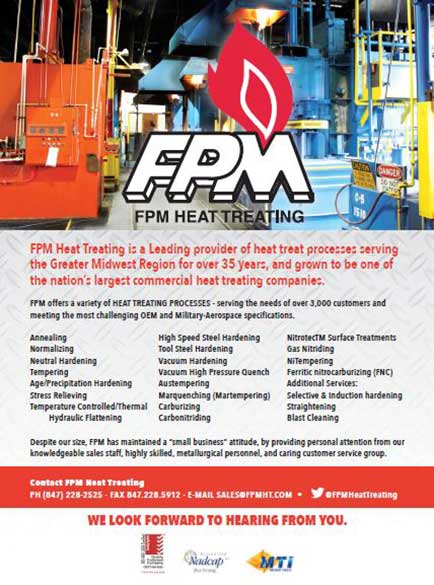
PROCESSING. PLEASE WAIT...


White Paper: FPM
F'M Heat Treating opened its doors in January 1979 to serve the then-booming tool and die market in Chicago. Today, over 35 years later, FPM operates three facilities in two states and has become one of the Midwest’s largest commercial heat treaters.
Despite its growth, and its success, FPM has maintained a “small business” attitude. The company does this by providing personal attention from its knowledgeable sales staff, highly skilled metallurgical personnel and experienced customer-service group.
This longtime MTI member offers a wide range of heat- treating services to over 3,000 customers in the greater Midwest manufacturing community. More specifically, FPM meets the needs of the automotive, aerospace, construction, consumer- product, machinery and tooling industries.
As mentioned, FPM operates facilities in Elk Grove Village, Ill.; Cherry Valley, Ill.; and Milwaukee, Wis. These locations perform a vast and diverse set of processes, including: annealing, normalizing, neutral hardening, tempering, age/precipitation hardening, stress relieving, tool-steel hardening, vacuum hardening, vacuum high- pressure gas quenching, austempering, marquenching, carburizing, carbonitriding, gas nitriding, ferritic nitrocarburizing (FNC), braz- ing, deep freezing, straightening and blast cleaning.
What truly makes FPM a unique operation, however, is the variety of processes – and equipment – available at each site. The company has also developed a strong niche when it comes to providing “outsourced” heat treatment to businesses that previously operated their own heat-treat department. These undertakings have involved entire operations, providing a significant source of backup/overflow heat-treating capacity.
As far as equipment goes, FPM has a lot to offer its customers. For example, the company’s batch furnaces are capable of processing large gears and shafts as well as small stampings and machine parts. With a maximum load capability of 3,000 pounds, these units measure 36 x 36 x 48 inches. FPM’s continuous belt furnaces are designed for high-volume processing of fasteners and other small- dimension parts – up to 5,000 pounds per hour. The company’s vacuum furnaces feature computer-controlled processing, up to 10- bar rapid gas quenching and maximum 5,000-pound load capacity. FPM also owns the North American license to Nitrotec, a nitriding-oxidizing-protection process that provides a highly corrosion- and wear-resistant finish in one sequence. This treatment eliminates the time and handling of secondary plating operations and allows for the use of lower-priced carbon steel in place of alloyed steels. It can be used as an environmentally friendly improvement to many plating processes, and it provides excellent scuffing and seizure resistance.
Yet another example that sets FPM apart is its Nadcap accreditation, which is difficult to achieve and maintain with its focus on processing details and quality documentation. Along those same lines, FPM’s metallurgical laboratories are a huge asset. Staffed by highly trained metallurgical technicians and degreed metallurgists, these labs are responsible for measuring and verifying critical characteristics of components, ensuring compliance with customer and applicable industry specifications. Equipped to perform not only traditional sectioning and microstructural evaluations, FPM’s labs offer varying degrees of failure analysis, alloy identification and nondestructive evaluations.
So, what does the future hold for FPM? Most likely another 35 years of growth and success. To get there, the company plans on expanding its Nadcap accreditation, upgrading furnace controls, installing new equipment and adding to its customer base and market area. For more information on FPM Heat Treating, visit www.fpmht.com.


 2025 All Rights Reserved | by: www.ciowhitepapersreview.com
2025 All Rights Reserved | by: www.ciowhitepapersreview.com